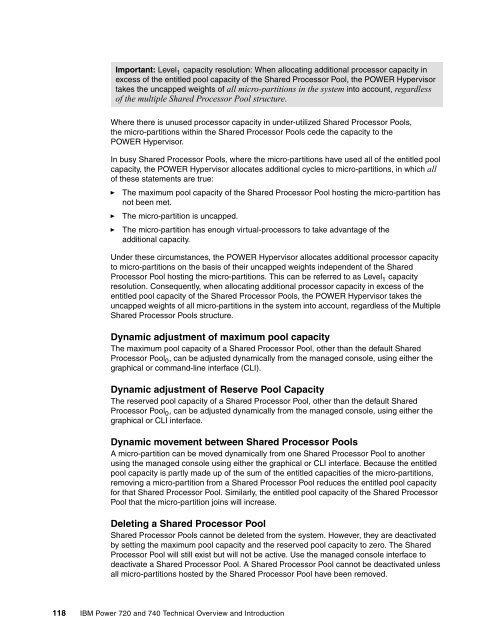You also want an ePaper? Increase the reach of your titles
YUMPU automatically turns print PDFs into web optimized ePapers that Google loves.
Important: Level 1 capacity resolution: When allocating additional processor capacity in<br />
excess of the entitled pool capacity of the Shared Processor Pool, the POWER Hypervisor<br />
takes the uncapped weights of all micro-partitions in the system into account, regardless<br />
of the multiple Shared Processor Pool structure.<br />
Where there is unused processor capacity in under-utilized Shared Processor Pools,<br />
the micro-partitions within the Shared Processor Pools cede the capacity to the<br />
POWER Hypervisor.<br />
In busy Shared Processor Pools, where the micro-partitions have used all of the entitled pool<br />
capacity, the POWER Hypervisor allocates additional cycles to micro-partitions, in which all<br />
of these statements are true:<br />
► The maximum pool capacity of the Shared Processor Pool hosting the micro-partition has<br />
not been met.<br />
► The micro-partition is uncapped.<br />
► The micro-partition has enough virtual-processors to take advantage of the<br />
additional capacity.<br />
Under these circumstances, the POWER Hypervisor allocates additional processor capacity<br />
to micro-partitions on the basis of their uncapped weights independent of the Shared<br />
Processor Pool hosting the micro-partitions. This can be referred to as Level 1 capacity<br />
resolution. Consequently, when allocating additional processor capacity in excess of the<br />
entitled pool capacity of the Shared Processor Pools, the POWER Hypervisor takes the<br />
uncapped weights of all micro-partitions in the system into account, regardless of the Multiple<br />
Shared Processor Pools structure.<br />
Dynamic adjustment of maximum pool capacity<br />
The maximum pool capacity of a Shared Processor Pool, other than the default Shared<br />
Processor Pool 0 , can be adjusted dynamically from the managed console, using either the<br />
graphical or command-line interface (CLI).<br />
Dynamic adjustment of Reserve Pool Capacity<br />
The reserved pool capacity of a Shared Processor Pool, other than the default Shared<br />
Processor Pool 0 , can be adjusted dynamically from the managed console, using either the<br />
graphical or CLI interface.<br />
Dynamic movement between Shared Processor Pools<br />
A micro-partition can be moved dynamically from one Shared Processor Pool to another<br />
using the managed console using either the graphical or CLI interface. Because the entitled<br />
pool capacity is partly made up of the sum of the entitled capacities of the micro-partitions,<br />
removing a micro-partition from a Shared Processor Pool reduces the entitled pool capacity<br />
for that Shared Processor Pool. Similarly, the entitled pool capacity of the Shared Processor<br />
Pool that the micro-partition joins will increase.<br />
Deleting a Shared Processor Pool<br />
Shared Processor Pools cannot be deleted from the system. However, they are deactivated<br />
by setting the maximum pool capacity and the reserved pool capacity to zero. The Shared<br />
Processor Pool will still exist but will not be active. Use the managed console interface to<br />
deactivate a Shared Processor Pool. A Shared Processor Pool cannot be deactivated unless<br />
all micro-partitions hosted by the Shared Processor Pool have been removed.<br />
118 <strong>IBM</strong> Power 720 and 740 Technical Overview and Introduction

















